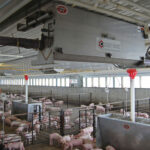Gleaner Super Series Combines With Natural Flow
Introduced in North America in 2010, and soon to be launched in Australia, the Gleaner continues to be a big success. One of the main things that makes a Gleaner Super Series combine unique is Natural Flow™ feeding and threshing. With...
Gleaner Super Series Combines With Natural Flow
Introduced in North America in 2010, and soon to be launched in Australia, the Gleaner continues to be a big success. One of the main things that makes a Gleaner Super Series combine unique is Natural Flow™ feeding and threshing. With...Introduced in North America in 2010, and soon to be launched in Australia, the Gleaner continues to be a big success. One of the main things that makes a Gleaner Super Series combine unique is Natural Flow™ feeding and threshing. With the rotor setting the width of the combine, the crop does not compress or change directions when moving from the feeder house to the rotor.
The process begins as grain enters the machine through the 69-inch (1,752 mm) long by 39.5-inch (1,003 mm) wide feeder house that is powered by an 8 5/8-inch (219 mm) diameter front feed drum. The feeder house can be reversed with the touch of a button from the operator’s seat in the event of a plug.
front feed drum. The feeder house can be reversed with the touch of a button from the operator’s seat in the event of a plug.
The feeder house pivots vertically at the first chain, anchoring the rear chain on a fixed angle regardless of header height. The second chain outpaces the first by 6 percent to prevent bunching. Four-strand undershot feed chains offer 33 percent more chain support than competitive three-strand feed chains to help prevent bent feeder slats.
In addition to keeping the crop moving in a smooth ribbon from feeding to threshing, the Natural Flow system has an additional feature that distinguishes it from competitors’ designs. Because the rotor is moving in line with the way the crop is fed into the machine, material is pulled into the rotor rather than being pushed in from the feeding system. This is a significant advantage in ensuring smooth feeding and reducing plugs. Bottlenecks are reduced because a Gleaner does not narrow the crop mat when moving from the feeder house to the rotor. The width of crop mat remains the same from the time it enters the feeder house to the time it enters the rotor, also reducing plugs and increasing threshing efficiency.
Stay tuned for an announcement of some live AGCO Chats with Kevin Bien, AGCO’s Product Marketing Manager for Combines in North America. What questions do you want Kevin to answer about the Super Series combines?



